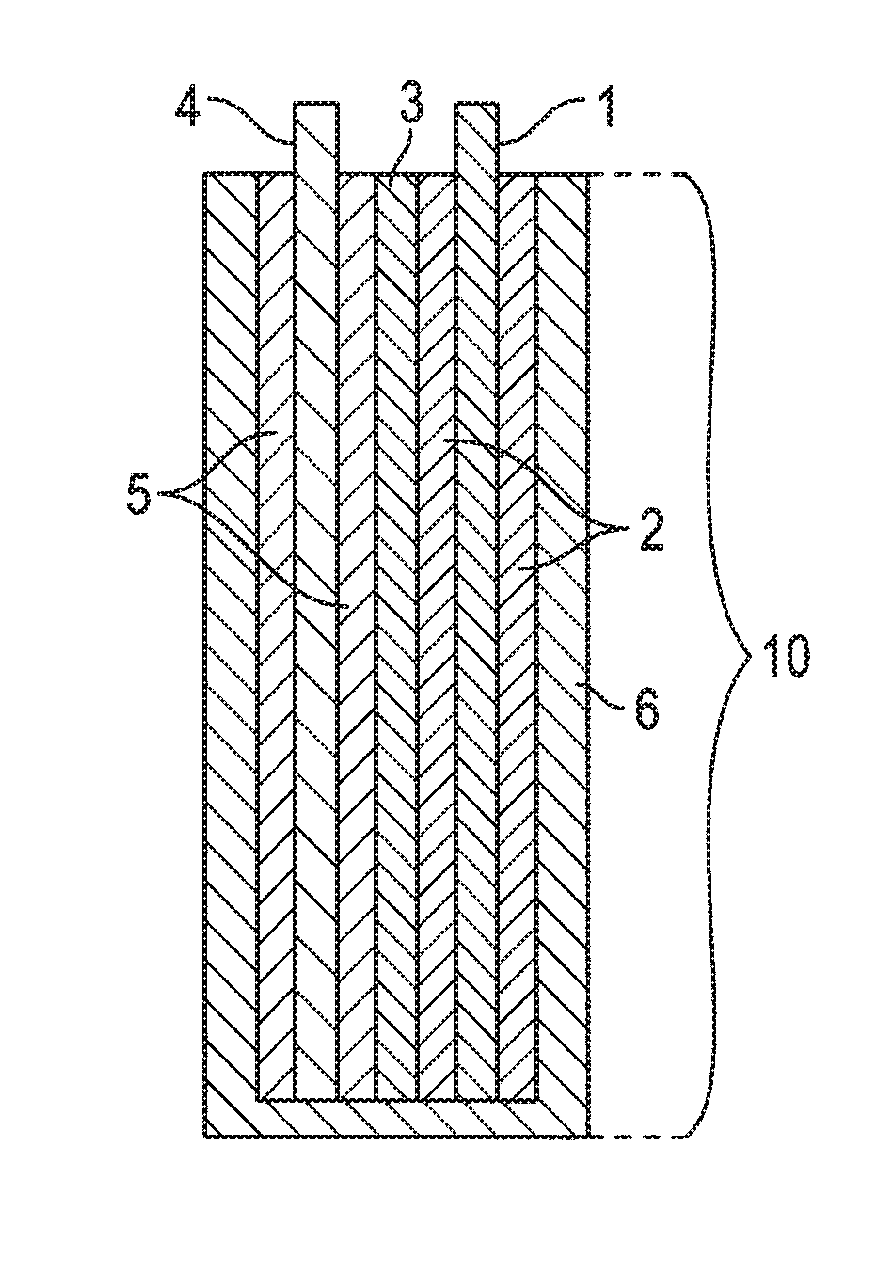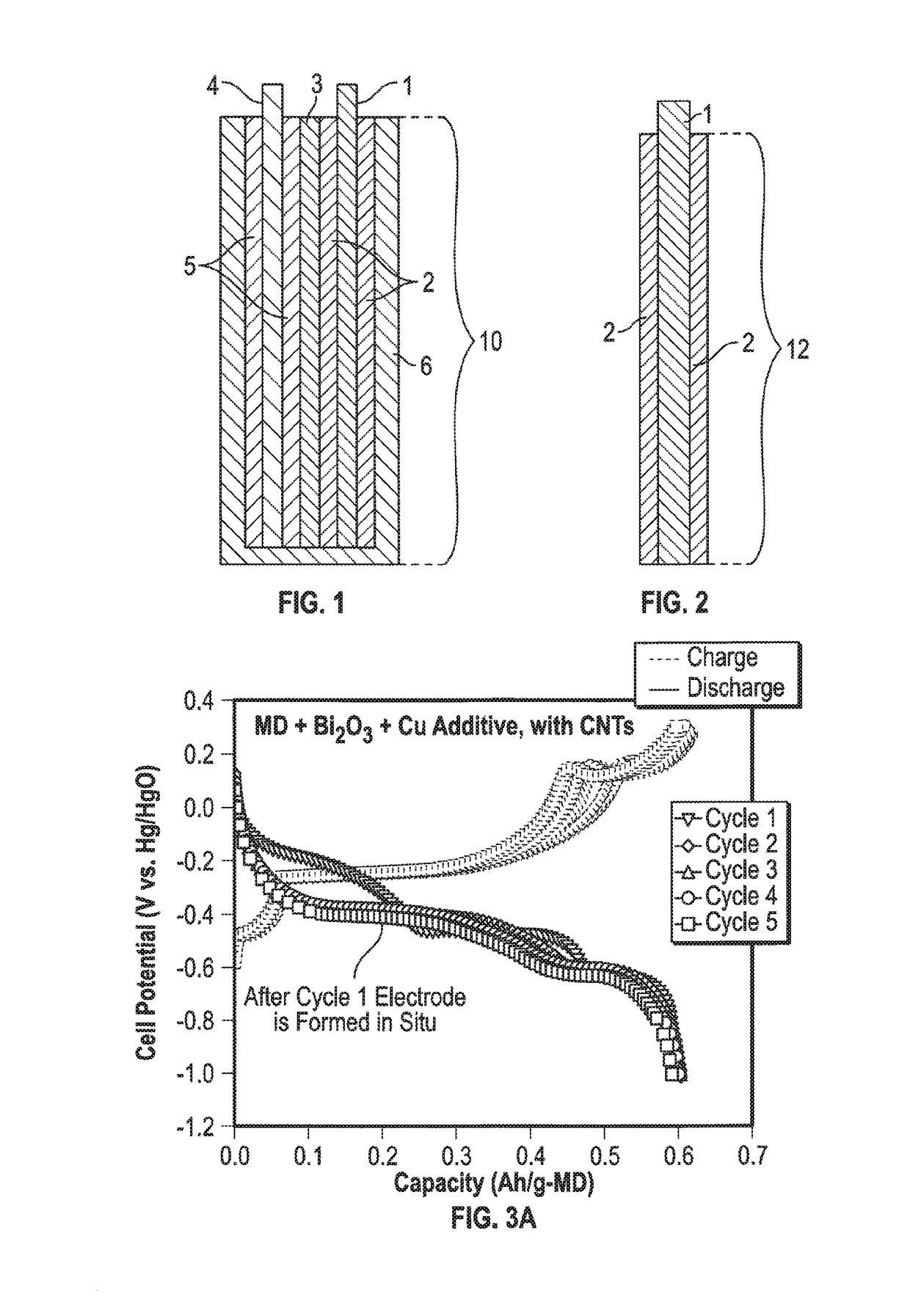Mixed Material Cathode for Secondary Alkaline Batteries
a technology of mixed materials and alkaline batteries, applied in the field of batteries, can solve the problems of large material wastage, undesirable environmental consequences, and products that are not amenable to charge-discharge cycling,
- Summary
- Abstract
- Description
- Claims
- Application Information
AI Technical Summary
Benefits of technology
Problems solved by technology
Method used
Image
Examples
example 1
[0039]To test the effect of adding copper metal or its derivatives to the mixed material cathode, two electrodes were made, a controlled electrode where there was no copper in the mix and an electrode where there was copper. Both the electrodes contained electrolytic manganese dioxide (EMD) and a bismuth oxide as an additive. The cathode with copper was made by mixing 1.3 g MnO2 (Tronox), 0.26 g Bi2O3, 1.04 g carbon nanotubes (CNTs), and 0.29 g CMC-PVA as a binder. To the resulting paste was added 2.82 g of copper metal. Thus the final composition of the cathode material was (by mass) 22.8% MnO2, 4.6% Bi2O3, 18.2% CNTs, 5.1% binder, and 49.3% copper. The resulting cathode material was pressed on a 6 in2 nickel mesh which was the cathode current collector. The electrode was dried. The electrode with the copper additive will be mentioned as mixed material cathode. The control cathode without copper was made identically, with the same masses of materials, excluding copper.
[0040]The mix...
example 2
[0042]This example was meant to demonstrate that the mixed material cathodes could be fabricated using various conductive carbons. A graphite-containing mixed material cathode was fabricated by mixing 19.2 mg bismuth-modified MnO2, 161.3 mg KS44 graphite, and 88.2 mg CMC-PVA as a binder. To the resulting paste was added 470 mg of copper metal. Thus the final composition of the cathode material was (by mass) 2.6% Bi-MnO2, 21.8% graphite, 11.9% binder, and 63.6% copper. The molar ratio of Mn chloride to Bi chloride used in the reaction to make the birnessite-phase bismuth-MnO2 was 8:1. CMC-PVA comprised 10 wt. % of the electrode mix. This cathode material was pressed on a 1 sq in. nickel mesh and the electrode was dried. For comparison a CNT-containing mixed material cathode was fabricated by mixing 135.9 mg MnO2, 27.2 mg Bi2O3, 108.7 mg CNTs, and 30.2 mg CMC-PVA as a binder. To the resulting paste was added 470 mg of copper metal. Thus the final composition of the cathode material wa...
example 3
[0045]The performance of the mixed material cathode was tested against a zinc electrode in a battery. The mixed material cathode was made by mixing 0.55 g MnO2 (Tronox), 0.11 g Bi2O3, and 0.44 g carbon nanotubes (CNTs), with no binder. Instead of binder a few drops of water was used to form the initial paste. To this paste was added 0.47 g of copper metal. Thus the final composition of the cathode material was (by mass) 35% MnO2, 7% Bi2O3, 28% CNTs, and 30% copper. The resulting cathode material was pressed on a 6 in2 nickel mesh which was then wrapped around the cathode material. The zinc electrode comprised of 13.6 g zinc powder, 1.6 g zinc oxide, and 0.8 g TEFLON®. The zinc anode was pasted and pressed on a copper mesh. Both electrodes were dried.
[0046]The mixed material cathode was compressed with zinc anodes in a prismatic box. The cell was filled with 6M potassium hydroxide. The cathode was cycled between 0.4 and 1.75V versus the zinc at C / 3.
[0047]FIG. 5 shows the charge and d...
PUM
| Property | Measurement | Unit |
|---|---|---|
| pressure | aaaaa | aaaaa |
| temperature | aaaaa | aaaaa |
| temperature | aaaaa | aaaaa |
Abstract
Description
Claims
Application Information
 Login to View More
Login to View More - R&D
- Intellectual Property
- Life Sciences
- Materials
- Tech Scout
- Unparalleled Data Quality
- Higher Quality Content
- 60% Fewer Hallucinations
Browse by: Latest US Patents, China's latest patents, Technical Efficacy Thesaurus, Application Domain, Technology Topic, Popular Technical Reports.
© 2025 PatSnap. All rights reserved.Legal|Privacy policy|Modern Slavery Act Transparency Statement|Sitemap|About US| Contact US: help@patsnap.com



